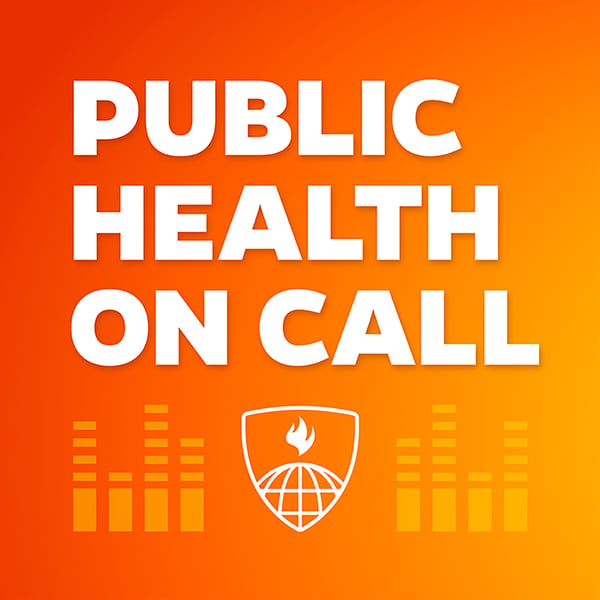889 - Zyn Nicotine Pouches
Public Health On Call
The Johns Hopkins Bloomberg School of Public Health
4.8 • 620 Ratings
🗓️ 30 April 2025
⏱️ 18 minutes
🧾️ Download transcript
Summary
About this episode:
Zyn nicotine pouches are suddenly everywhere. What are they and how can they impact health? In this episode: A look at the popular products, what they are and how they work, how they’re marketed, and what we know—and don’t yet know—about their long-term health impacts or whether they could be a tool to help people quit tobacco products.
Guest:
Meghan Moran is an associate professor in the Department of Health, Behavior and Society at the Johns Hopkins Bloomberg School of Public Health, and a researcher who studies how communications from advertising to misinformation shape public health issues such as vaccine promotion, cancer screening, and tobacco control.
Johannes Thrul is an associate professor in the Department of Mental Health at the Johns Hopkins Bloomberg School of Public Health, and a substance use disorder researcher.
Host:
Lindsay Smith Rogers, MA, is the producer of the Public Health On Call podcast, an editor for Expert Insights, and the director of content strategy for the Johns Hopkins Bloomberg School of Public Health.
Show links and related content:
-
A Cross-Sectional Survey on Oral Nicotine Pouches; Characterizing Use—Motives, Topography, Dependence Levels, and Adverse Events—Nicotine & Tobacco Research
-
What’s That in Your Mouth, Bro?—The New York Times
-
What We Know (and Don’t) About Nicotine Pouches—Johns Hopkins Bloomberg School of Public Health
-
Electronic Cigarettes Part 1: Do E-cigs Help People Quit Smoking?—Public Health On Call (May 2024)
-
Electronic Cigarettes Part 2: How Serious are the Health Risks Associated with E-cigs?—Public Health On Call (May 2024)
Transcript information:
Looking for episode transcripts? Open our podcast on the Apple Podcasts app (desktop or mobile) or the Spotify mobile app to access an auto-generated transcript of any episode. Closed captioning is also available for every episode on our YouTube channel.
Contact us:
Have a question about something you heard? Looking for a transcript? Want to suggest a topic or guest? Contact us via email or visit our website.
Follow us:
-
Here's our RSS feed
Note: These podcasts are a conversation between the participants, and do not represent the position of Johns Hopkins University.
Transcript
Click on a timestamp to play from that location
| 0:00.0 | Welcome to Public Health On Call, a podcast from the Johns Hopkins Bloomberg School of Public Health, |
| 0:05.9 | where we bring evidence, experience, and perspective to make sense of today's leading health challenges. |
| 0:16.3 | If you have questions or ideas for us, please send an email to public health question at jhh.edu. |
| 0:23.8 | That's public health question at jhhu.edu for future podcast episodes. |
| 0:31.4 | It's Lindsay Smith-Rogers. |
| 0:33.5 | Today, all about Zin. |
| 0:36.2 | Researchers Megan Moran and Yohanna Sthrill join me to talk about Zinn. Researchers, Megan Moran and Johannes Thrill join me to talk about |
| 0:39.9 | Zin nicotine pouches, what they are and how they work, how they're marketed, and what we know |
| 0:45.7 | and don't know about their long-term health effects and whether they could be a viable tool for |
| 0:51.2 | helping people to quit tobacco products. Let's listen. Megan Moran and |
| 0:55.4 | Johannes Thorel, thank you so much for joining us on public health on call today. We're going to be |
| 1:00.2 | talking about Zinn. And so to start us off, what is Zinn? Megan, we'll start with you. |
| 1:06.5 | So Zin is a brand of oral nicotine pouch owned by Philip Morris International. It's not the only |
| 1:13.4 | brand of oral nicotine out there. It just is, I think, the most popularly used one and the one that's |
| 1:19.3 | getting the most immediate attention. So to kind of scope out a little bit, oral nicotine pouches |
| 1:25.0 | are these little pouches that contain nicotine powder, |
| 1:29.3 | and they're placed between the gum and the lip. |
| 1:32.8 | They come in a variety of nicotine strengths and flavors such as citrus, coffee, mint. |
| 1:39.5 | What makes these different from other products that might have been similar in the past? |
| 1:44.0 | So they're being marketed primarily as being, quote, tobacco-free, which is just another way of |
| 1:51.4 | saying that the nicotine in them is synthetically made in a laboratory as opposed to coming |
| 1:57.5 | directly from a tobacco leaf. And Johannes, let's talk about what we know about nicotine and health. |
... |
Please login to see the full transcript.
Disclaimer: The podcast and artwork embedded on this page are from The Johns Hopkins Bloomberg School of Public Health, and are the property of its owner and not affiliated with or endorsed by Tapesearch.
Generated transcripts are the property of The Johns Hopkins Bloomberg School of Public Health and are distributed freely under the Fair Use doctrine. Transcripts generated by Tapesearch are not guaranteed to be accurate.
Copyright © Tapesearch 2025.

